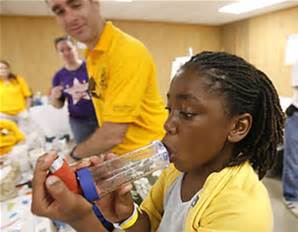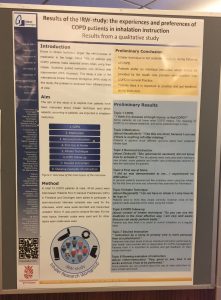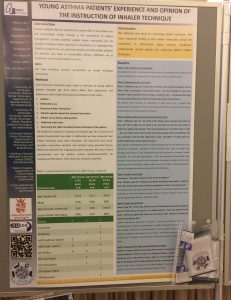The new IRW instruction method was rewarded at the IPCRG in Portugal!
At the IPCRG conference in Porto our abstract entitled “Development of a new inhaler technique instruction method: based on the Inhaler Research Workgroup study” was one of the four prize winning abstracts.

Nederlandstalige IRW-nieuwsbrief zomer 2017!
Volg de link naar Newsletters
New newsletter IRW study!
Follow the link to the Newsletters
Gillette et al published a systematic review regarding inhaler technique in children
Inhaler technique in children is poor

The researchers included 28 studies and evaluated the prevalence of poor inhaler technique, effective educational interventions and the relation between inhaler technique and asthma control. Inhaler technique in children is poor, although the range of children with correct inhaler technique varied between studies and devices (range 0%-97% correct). Education can improve technique regardless the setting (online or in a clinic) or instructor (nurse, pharmacist or physician). Health care providers rarely evaluate inhaler technique in children. Inhaler technique can be improved by explaining the child what an inhaler is, how it works and how to use it. Above that, inhaler technique should be regularly monitored. Including different health care professionals (e.g. nurses and pharmacists) will improve technique. There is little research on the relation of inhaler technique and asthma outcomes.

Pharmacists can improve inhaler technique in patients
Effectiveness of Various Methods of Teaching Proper Inhaler Technique: The Importance of Pharmacist Counseling by Axtell and others
In this study a comparison was made between reading a package insert pamphlet, watching a video with inhaler instructions and receiving direct 2 minute instruction from a pharmacist. 72 healthy inhaler naive participants were included. Directly after the instruction, participants demonstrated their inhaler technique with a placebo and were rated according to 7 critical errors. Approximately 70% of the participants showed the correct inhaler technique after the pharmacist instruction.

Impact of community pharmacists in COPD management: Inhalation technique and medication adherence, by Hesso and others
In this publication 10 articles regarding the impact of community pharmacists on COPD management were assessed. Inhaler technique and medication adherence were evaluated in these studies. Results showed that pharmacists interventions are effective in improving inhaler technique and adherence. Pharmacists should more intensively be involved in the management of COPD. Moreover, the authors advice to develop new studies to evaluate the most effective frequency of inhaler instructions.

Presentations by our IRW members at the IPCRG in Amsterdam
Several members of our research team have presented during the International Primary Care Respiratory Group conference in Amsterdam. Marina Garcia from Spain has presented the study design from the IRW project. Esther Metting presented the results from the interviews performed in the COPD patients younger than 65 years. An finally Titia Klemmeier gave a workshop with co presenter Ruth McArthur from Scotland (Ruth is not involved in the IRW study).

IRW researchers at the “Longdagen 2016”
Researchers Warner Postma and Esther Metting have presented 2 posters with results from the IRW study at the yearly conference of the Dutch Lung Foundation in the Netherlands.


Great article by Mark Levy and colleagues
“Inhaler technique: facts and fantasies. A view from the Aerosol Drug Management Improvement Team (ADMIT)”
The researchers performed a literature search and evaluated 10 common beliefs about inhaler technique held by health care professionals regarding:
- pMDI inhaler devices should be shaken
- Spacer design and construction make a difference
- Breath-holding after inhalation is clinically beneficial
- Rinsing of the mouth after using an inhaler is clinically beneficial
- Moisture and dry powder inhalers (DPIs)
- Patients can determine when their pMDI is empty
- The use of a single design of inhaler to deliver different inhaled drugs improves clinical outcomes
- Patients who use an inhaler device they prefer have better outcomes
- Dysphonia is caused by particular inhaler devices and changing the device may relieve it
- Regular and proper use of inhaler devices improves asthma outcomes
Source PCRM, Levey et al 2016)
Factors associated with poor inhaler control
Characteristics of patients making serious inhaler errors with a dry powder inhaler and association with asthma-related events in a primary care setting
An international group of researchers from the iHARP study, among them IRW member prof. van der Molen, found that serious inhaler technique errors are related to asthma-related hospitalization in the previous year, obesity, poor asthma control in the previous 4 weeks, female sex and no inhaler instruction in the previous year. The inhaler technique of patients with poor inhaler technique should always be reviewed.
From: Journal of asthma, January 2016. J.Westerik et al. Link to article
This is an iHARP study (initiative Helping Asthma in Real-life Patients)
